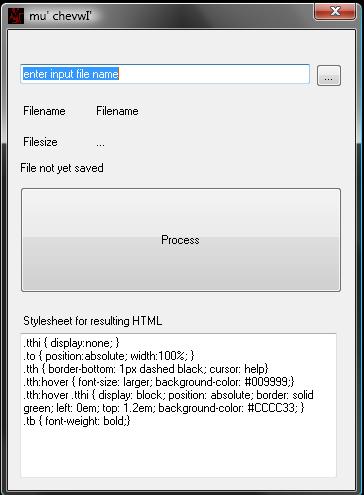
|Home
|Feature Index
|Site Index
|Matroska
|Advertisement
|mu' DelwI'
|mu'chevwI'
|Links
|Top

 As the name suggests, it separates words. Splits them into syllables, and tries to find a translation for them.
As the name suggests, it separates words. Splits them into syllables, and tries to find a translation for them.| Firefox | Should work just fine. I'm doing all primary tests with it, since I don't really use any fance coding, even older versions shouldn't have any problems. |
| Opera | I tested it with a recent version, no problems. Unlikely that older versions have trouble. |
| Internet Explorer | Ah yes, here it comes. I think it is obvious that anything below version 7 won't even remotely work. Version 5 is outdated and 6 is a rotting corpse. MS had no interest in providing good HTML/CSS support. Anyway. Version 7 seems to have problems with the pseudo-class ":active". I have therefore added a predfined custom-stylesheet for IE7 into the program. It will be invoked via conditional comments only by IE7, all others will ignore it. Instead of :active, :hover is used - which means that the text is displayed as soon as you just HOVER above the word. That is hardcoded, I'm afraid. The rest, though, can be changed through the user stylesheet. Version 8 of IE should be able to work with the created HTML - however, it will be slow if the page is too long. (Which is, unfortunately not much.) I'm trying to find a solution, but until then I suggest you either switch to a decent browser - Firefox, Safari, Opera, take your pick. Just not IE. Perhaps version 9 will be up to yesterday... Update:Thanks to XHTMLForum.de, I now know the reason why it's slow with IE. Apparently, it doesn't like all those inline containers. Switching to float would help. Unfortunately, I can't get it working with float - the design is ruined every time. I'm sorry, but it's not important enough for me to try to fix it any further. I'd rather fix important bugs in the program, than work around a single browser. If you have a working stylesheet, please send me. I'm not against making it usable in IE :-) |